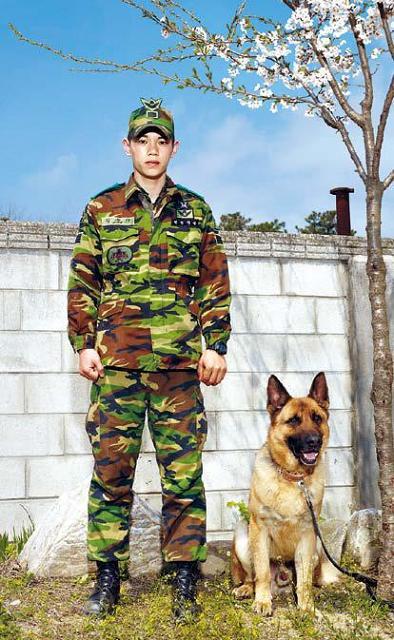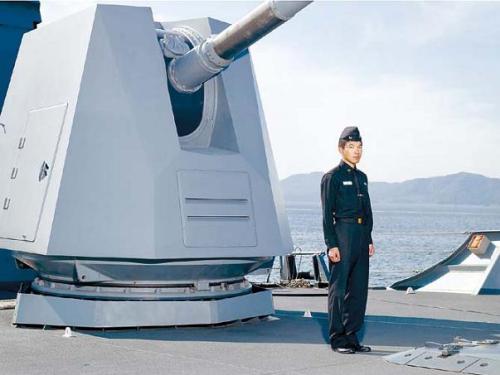
“The Cherry Blossom Tree, a Soldier and the Army Dog, ‘The Big Bear’” (Artsonje Center)
One photographer, well-known for portraits capturing the anxiety in individuals, had never taken portraits of men as they are not good at revealing their inner selves.
But captivated by the instability and anxiety he saw in young soldiers, Oh Hein-kuhn began to document them as “middlemen” who are isolated from the outside world and caught in the middle of conflicts between the individual and the collective in the military.
“The young soldiers seem unstable being isolated from the outside world and I wanted to capture that instability and fragility in them,” said Oh at the opening of his exhibition “Middlemen” last week at Artsonje Center in Seoul.
Oh is the first photographer to capture soldiers’ individual personalities rather than the collective military image in the history of the Korean military.
He said he didn’t take pictures of higher rankings officers, but only those young men serving their mandatory military service.
The three-year project, begun in 2009 with the support of the Ministry of National Defense, documents young soldiers serving in the Army, Navy and Air Force.
“There have never been photos uncensored and not controlled in the history of the Korean military. Photos from the military are usually seen as masculine, powerful ― the military stereotype,” said Oh.

“A Petty Officer Standing in Front of 127mm Naval Artillery Gun” (Artsonje Center)
“They usually pick a couple of soldiers fit to represent the military image. But I told them I wanted to capture the most frank side of the soldiers and I waited for those moments,” said Oh.
In order to capture the ambiguous “middleness,” he keeps a neutral attitude with the use of a middle tone and lighting, to reveal just the individuals, not adding any criticism or positive attitude toward the military.
Oh said he didn’t want any artificial settings; rather, he tried to capture the most natural moments.
In one photo, a pilot stands next to a jet with its nose facing him.
“That spot happened to be where he got off from the truck to meet me,” Oh said.
The exhibition is divided into three sections with each focusing on different components of the pictures.
The first section presents the bright portraits of soldiers in order to emphasize the ambiguous sense of isolation.
The background is equally highlighted as is the person in the front, almost blurring the lines between the subject and the background.
The mood in the second section is decidedly gloomy and dark, featuring portraits in which Oh intended to accentuate the anxiety and the feelings of isolation and struggles between “we” and “I.”
The last section, which Oh considers the highlight of the exhibition, shows a group of conventional individual portrait photographs that concentrate on the persons.
Whereas the background plays an important role in the previous two sections, Oh focuses on the person in the work featured in this section, telling stories of each through a very detailed portrayal.
Drawn by the anxieties of the Korean people, Oh previously documented middle-aged women and high school girls as subjects in the middle ground. Middle-aged women not exactly considered professional working women or housewives and high school girls are in a state between being young girls and ladies.
“Good pictures are those that cause social reaction. Photos are like passages through which one can view the society,” said Oh.
The exhibition runs through June 17 at Artsonje Center in Jongno from Tuesday to Sunday. Opening hours are from 11 a.m. to 7 p.m. and docent tours will be provided four times a day at every hour from 2 p.m. to 5 p.m. Admission is 3,000 won for adults and 1,500 for students.
By Lee Woo-young (
wylee@heraldcorp.com)







